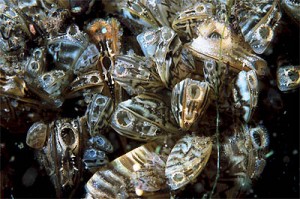From a Montana Mussel Response press release . . .

National Invasive Species Awareness Week comes at a unique time for Montana, as Fish, Wildlife and Parks and the Department of Natural Resources and Conservation continue their joint efforts to implement a plan to fight aquatic invasive mussels.
“We take the fight against invasive species in Montana very seriously and continue to be vigilant in addressing threats to Montana’s critical infrastructure, economy and recreational way of life,” said Montana Gov. Steve Bullock.
NISAW runs from Feb. 27 through March 3 to raise awareness and identify solutions for invasive species at the local level. The Montana Invasive Species Advisory Council encourages Montanans to participate in local events and offers ways you can help observe.
“Invasive species cost the U.S. economy an estimated $137 billion a year and are a leading cause in the loss of biodiversity,” said Bryce Christiaens, chair of the Montana Invasive Species Advisory Council. “But you can help. Just by simply cleaning your recreational equipment before going out for the weekend, you can help prevent the spread of these species in Montana.”
Invasive species include plants, animals and insects that cause economic or ecological harm to a new environment in which they have been introduced. These introduced species, while beneficial to their home areas, can cause problems in their new environment because predators and other environmental limiting factors do not exist, allowing them to spread at alarming rates.
In Montana, the latest invader is invasive mussels that were detected at Tiber and Canyon Ferry reservoirs in fall 2016. Montana is also impacted by other invasive species such as the New Zealand mudsnail, houndstongue, and Eurasian watermilfoil are among the wide variety of invasive organisms that threaten agricultural productivity, forest health, water quality, fish and wildlife habitat, and property.
The expansion of harmful introduced species is one of the single largest threats to the nation’s natural resources. Invasive species:
- Reduce agricultural production,
- Reduce property values,
- Decrease biodiversity and disrupt ecosystems,
- Displace native species that fish and wildlife require,
- Increase soil erosion and bank failure and clog waterways,
- Increase the severity and frequency of wildfires, and
- Further threaten endangered and rare species.
Residents can take simple actions to help prevent the introduction and spread of noxious weeds and invasive species:
- Learn about invasive species and report outbreaks to authorities. Visit the websites of the state invasive species councils to find information on phone hotlines, mobile apps, or reporting forms.
- Clean hiking boots, waders, boats and trailers, off-road vehicles and other gear to stop invasive species from hitching a ride to a new location. Learn more about preventing spread at protectyourwaters.net.
- Avoid dumping aquariums or live bait into waterways. Follow directions about disposal of school science kits. Teachers can get more information at wise.wa.gov/solutions/teacher.aspx, OR website, ID website, MT website.
- Don’t move firewood – instead, buy it where you’ll burn it, or gather on site when permitted. Learn more at DontMoveFirewood.org
- Use forage, hay, mulch that is certified as weed free. Learn more by visiting https://www.naisma.org/weed-free-forage Plant only non-invasive plants in your garden, and remove any known invasive plants. Consider planting all native species. Learn more by contacting your local native plant society or master gardener chapter.
- Volunteer in a Citizen Science invasive species detection program.
- Volunteer to help remove invasive species from public lands and natural areas.
About the Montana Invasive Species Advisory Council
The Montana Invasive Species Advisory Council was created by the Montana Governor’s office in 2015 and tasked with identifying priority invasive species issues and making recommendations to improve invasive species management.
Since its inception, the Council conducted a statewide assessment of its invasive species management programs, held an invasive species summit and statewide listening sessions to share the results of the assessment, develop a shared understanding of invasive species issues and solutions
After two-years of analysis, assessment, and vetting with stakeholders, the Montana Invasive Species Strategic Framework was completed December 1, 2016. This framework, in part, serves as the roadmap for recommended actions in this Invasive Mussel Framework.
For more information